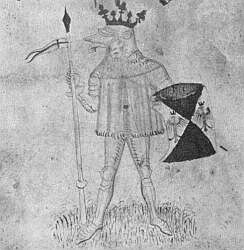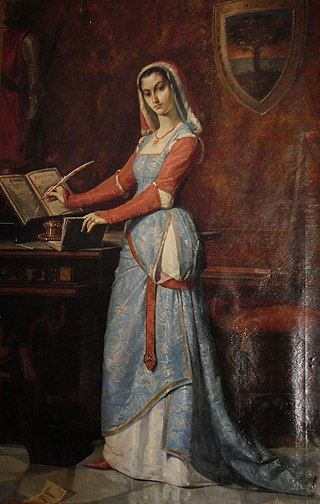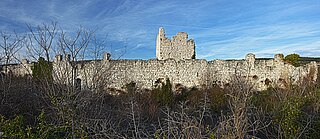
Martin I of Sicily, called "The Younger", was King of Sicily from his marriage to Queen Maria in 1390 until his death.

Eleanor of Arborea or Eleanor De Serra Bas was one of the most powerful and important, and one of the last, judges of the Judgedom of Arborea in Sardinia, and Sardinia's most famous heroine. She is also known for updating of the Carta de Logu, promulgated by her father Marianus IV and revisited by her brother Hugh III.
Luciano Laurana was an Italian architect and engineer from the historic Vrana settlement near the town of Zadar in Dalmatia, After education by his father Martin in Vrana settlement, he worked mostly in Italy during the late 15th century. He was principal designer of the Palazzo Ducale of Urbino and one of the main figures in 15th-century Italian architecture. He considerably influenced the development of Renaissance architecture. His projects were accompanied with notes in the Croatian glagolitic script, as witnessed by the famous Bernardo Baldi. He was a relative of the sculptor Francesco Laurana.

Eleanor of Austria, also called Eleanor of Castile, was born an Archduchess of Austria and Infanta of Castile from the House of Habsburg, and subsequently became Queen consort of Portugal (1518–1521) and of France (1530–1547). She also held the Duchy of Touraine (1547–1558) in dower. She is called "Leonor" in Spanish and Portuguese and "Eléonore" or "Aliénor" in French.

A bust is a sculpted or cast representation of the upper part of the human body, depicting a person's head and neck, and a variable portion of the chest and shoulders. The piece is normally supported by a plinth. The bust is generally a portrait intended to record the appearance of an individual, but may sometimes represent a type. They may be of any medium used for sculpture, such as marble, bronze, terracotta, plaster, wax or wood.

Eleanor of Aragon was a daughter of King Peter IV of Aragon and his wife Eleanor of Sicily. She was a member of the House of Barcelona and Queen of Castile by her marriage.

Eleanor of Alburquerque was a Castilian noblewoman, Countess of Alburquerque, who became Queen of Aragon by her marriage to Ferdinand I of Aragon. She was the regent of Aragon during the absence of her son the king in 1420.

Francesco Laurana, also known as Francesco de la Vrana was a Dalmatian sculptor and medallist. He is considered both a Croatian and an Italian sculptor. Though born in the territory of the Republic of Venice, he spent his mature career at the other end of Italy, moving between Naples and Sicily, and Urbino, and finally in southern France, where he died.

Castel Nuovo, often called Maschio Angioino, is a medieval castle located in front of Piazza Municipio and the city hall in central Naples, Campania, Italy. Its scenic location and imposing size makes the castle, first erected in 1279, one of the main architectural landmarks of the city. It was a royal seat for kings of Naples, Aragon and Spain until 1815.

Marianus IV, called the Great, was the Judge (king) of Arborea, kingdom in the island of Sardinia, from 1347 to his death. He was, as his nickname indicates, the greatest sovereign of Arborea. He was a legislator and a warrior whose reign saw the commencement of massive codification of the laws of his realm and incessant warfare with the Crown of Aragon. He was also a religious man, who had connections to Catherine of Siena. He was, in short, an "wise legislator, able politician, and valiant warrior."
Events from the year 1502 in art.

Archduchess Eleanor of Austria was Duchess of Mantua by marriage to William I, Duke of Mantua. She was the daughter of Ferdinand I, Holy Roman Emperor and Anna of Bohemia and Hungary.

Eleanor of Sicily (1325–1375) was Queen of Aragon from 1349 until 1375 as the third wife of King Peter IV.

Vrana is a historic settlement located north of the Vrana Lake, 6 kilometres (4 mi) from Pakoštane, a few kilometers from the Adriatic coast, in Zadar County, Dalmatia, Croatia. Today it is a small rural settlement.
Croats form a part of the permanent population of Italy. Traditionally, there is an autochthonous community in the Molise region known as the Molise Croats, but there are many other Croats living in or associated with Italy through other means. In 2010, persons with Croatian citizenship in Italy numbered 21,079.

The Marquisate of Oristano was a marquisate of Sardinia that lasted from 1410 until 1478

Bust of a Princess is a c.1468 marble sculpture by the Italian Renaissance sculptor Francesco Laurana. It was in the Condé family collection at château d'Écouen by 1793 and entered the Louvre in 1818, where it remains.

Bust of Isabella of Aragon or Ideal Portrait of Laura is a marble sculpture by Francesco Laurana, now in the Kunsthistorisches Museum in Vienna. It is the only one of the artist's sculptures still to retain the coloured wax he applied to it. Its idealisation draws on the works of Piero della Francesca, which Laurana may have seen in Urbino, and leads some to identify it as an ideal portrait of Petrarch's Laura.













